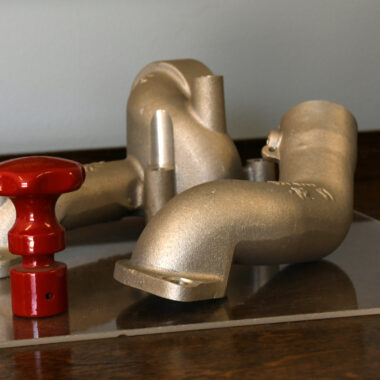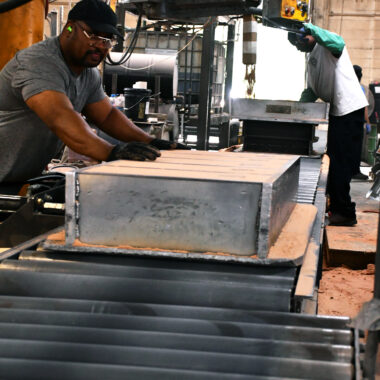Crafting Perfection: Just How to Attain High-Quality Light Weight Aluminum Castings Every Time
In the world of aluminum casting, the quest of excellence is a continual journey that needs a careful approach and a keen understanding of the ins and outs entailed. Achieving consistent top notch light weight aluminum spreadings demands an extensive understanding of the processes, from selecting the proper alloy to implementing precise mold designs and carefully regulating spreading criteria.
Recognizing Aluminum Spreading Procedures
Light weight aluminum casting procedures, necessary in the production industry, include the elaborate makeover of liquified aluminum right into strong kinds via a collection of meticulously regulated actions. Recognizing these procedures is extremely important to attaining high-quality light weight aluminum spreadings continually - about aluminum casting. The key approaches made use of in light weight aluminum casting are die casting, sand spreading, and financial investment casting

Each of these procedures has its benefits and is picked based upon variables like intricacy, quantity, and wanted coating of the light weight aluminum spreading. about aluminum casting. Comprehending the details of these approaches is critical for manufacturers intending to generate high-quality aluminum spreadings continually
Picking the Right Light Weight Aluminum Alloy
Selecting the ideal aluminum alloy is an important decision in the production of top quality aluminum castings. When choosing an aluminum alloy for casting, it is essential to think about the specific demands of the application to make certain optimal efficiency.
Among the most typically made use of aluminum alloys for casting is A356. This alloy uses superb castability, high strength, and great deterioration resistance, making it suitable for a wide variety of applications. Conversely, 6061 aluminum alloy is favored for its premium weldability and good mechanical buildings. For applications calling for high toughness, 7075 aluminum alloy is a popular choice because of its phenomenal strength-to-weight proportion.
In addition to mechanical residential or commercial properties, considerations such as cost, availability, and post-casting processes should also affect the option of the appropriate light weight aluminum alloy. By very carefully examining these aspects, makers can make sure the production of top notch aluminum castings that fulfill the wanted specs.
Carrying Out Appropriate Mold Layout
Creating an efficient mold layout is vital for making sure the successful production of high-grade aluminum castings. Proper mold and mildew style plays a considerable role in attaining the preferred qualities of the final item. To execute a successful mold and mildew design, variables such as product flow, cooling down rates, and component geometry should be carefully taken into consideration.
One key facet of mold layout is making sure proper dental filling and solidification of the light weight aluminum within the mold dental caries. This includes making runner and gating systems that facilitate smooth metal circulation and avoid issues such as air entrapment or incomplete dental filling. Additionally, integrating cooling channels right into the mold style aids control solidification prices and reduce the danger of porosity or shrinkage flaws.

Controlling Casting Parameters

Guaranteeing Post-Casting Top Quality Checks
To keep the high quality of aluminum castings, extensive post-casting top quality checks are vital. After the spreading process is completed, it is crucial to guarantee that the last items satisfy the Read Full Report wanted requirements and specifications.
Dimensional precision is one more important element that has to be validated during post-casting quality checks. Measurements of vital dimensions and resistances must be required to validate that the castings satisfy the needed requirements. Additionally, mechanical residential or commercial properties such as solidity, tensile toughness, and influence resistance might need to be evaluated via material testing to guarantee that the castings possess the necessary strength and sturdiness for their desired application.
Verdict
Finally, attaining high-grade light weight aluminum castings calls for an extensive understanding of the casting processes, picking the suitable alloy, developing mold and mildews properly, managing casting criteria carefully, and conducting post-casting high quality checks diligently. By complying with these steps, producers can constantly create aluminum spreadings that satisfy the highest requirements of high quality and performance.
Achieving consistent official site high-grade light weight aluminum castings requires an extensive understanding of the procedures, from choosing the proper alloy to implementing specific mold styles and meticulously regulating casting specifications. The primary techniques made use of in aluminum casting are die casting, sand casting, and financial investment spreading.
Investment spreading, likewise known as accuracy spreading, involves producing wax patterns that are covered in ceramic to create molds.Choosing the suitable aluminum alloy is a vital choice in the manufacturing of high-quality aluminum spreadings.Ensuring exact control over spreading parameters is crucial for preserving uniformity and top quality in aluminum spreading production.